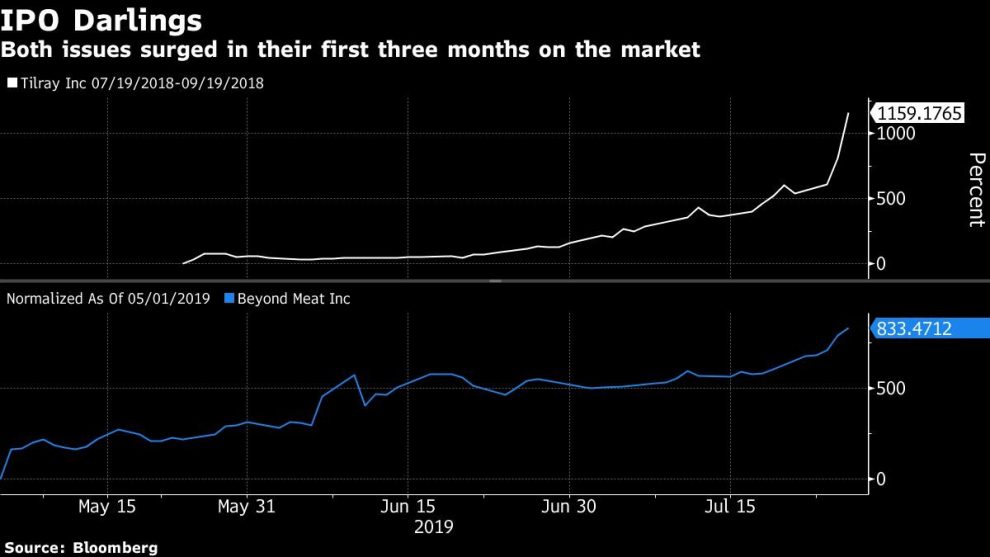
(Bloomberg) — Beyond Meat Inc.’s parabolic post-IPO surge is reminding investors of another high-flier on Wall Street — Tilray Inc. But a closer look suggests that other than the initial price moves, they share little in common.
Both stocks skyrocketed in the first few months of trading. Beyond Meat has now gained more than 800% since going public in early May while Tilray surged a whopping 1159% two months after debuting. Behind the rally is the same type of investor frenzy generated by a nascent industry when shares are in tight supply.
And that’s about where the similarities end. Tilray is part of a booming industry where cannabis products have been legalized or decriminalized in many countries. By contrast, the outlook for Beyond Meat is less certain as the company is seeking to change consumer tastes. Another key difference comes in the form of insider holdings, where Tilray seems to have a more solid backing.
For now, a less favorable backdrop has been ignored by Beyond Meat investors. Shares of the faux-meat company have enjoyed a smooth run-up in their first three months, with almost no major pullbacks. Tilray’s star status ended much earlier, with the stock peaking five weeks after its debut.
“There can be a number of things out there that would halt or potentially reverse the momentum,” Michael Antonelli, an institutional equity sales trader and managing director at Robert W. Baird & Co said. “That’s why investing positions like these aren’t for the faint of heart.”
Beyond Meat’s second-quarter earnings on Monday will serve as a key test. Shares have rallied 33% this week as the company has notched up another restaurant partner, Dunkin’ Brands Group Inc.
Below are a few charts that highlight some differences between the two companies:
The industry prospects for Tilray seem to be more certain, with an existing customer base for cannabis, which is transitioning to regulated products from illicit ones. Global legal cannabis spending is forecast to reach $17 billion this year, according to Arcview Market Research and BDS Analytics, but total purchases may be as high as $300 billion, research firm New Frontier data show.
New Market
The market for Beyond Meat, however, is less established, with analysts’ estimates ranging from $10 billion to $40 billion and to $140 billion over the next decade.
“Not only is it new, but it’s really one of a kind, there aren’t any other pure play public companies in this space,” said Antonelli. “Markets are really bad at figuring out what a company like that is worth because not only is the total market hard to define, it’s also hard to project how this brand new company will do.”
Also ambiguous is the position of Beyond Meat’s biggest shareholders. The top five owners, including CEO Ethan Brown, control a combined 34% of outstanding shares, according to data compiled by Bloomberg. Investors won’t know whether the holders intend to sell their stakes until late October, when the stock’s lockup period expires.
By contrast, Tilray’s largest shareholder, Peter Thiel’s Privateer Holdings Inc., owns 72% of the company’s outstanding common shares and has vowed to keep them.
“Everyone knows it’s a similar situation, with a small float, heavily shorted,” said Michael O’Rourke, chief market strategist at JonesTrading Institutional Services. But “obviously, it’s more of a supply-demand situation than anything else.”
Tilray saw much wilder swings in its first few months of trading. On Sept. 19, for example, the maker of cannabis products nearly doubled to $300 apiece, before wiping out the entire gain in less than an hour, only to finish 40% above where it started.
For Beyond Meat, its craziest session yet occurred on June 18, when the stock saw a 26% swing between its highest and lowest price.
While Beyond Meat’s rise from its IPO remains intact, the question is, when will the momentum turn? After all, it’s expected to post a loss of 26 cents a share this year, according to current estimates compiled by Bloomberg. Yet at $14 billion, its market value is more than double than that of chicken producer Pilgrim’s Pride Corp.
For bears looking for the potential downside, Tilray, also unprofitable, may offer some hints. The stock has never returned to its early highs, now trading about 80% below its September peak.
–With assistance from William Maloney.
To contact the reporter on this story: Tatiana Darie in New York at [email protected]
To contact the editors responsible for this story: Catherine Larkin at [email protected], Lu Wang, Morwenna Coniam
<p class="canvas-atom canvas-text Mb(1.0em) Mb(0)–sm Mt(0.8em)–sm" type="text" content="For more articles like this, please visit us at bloomberg.com” data-reactid=”66″>For more articles like this, please visit us at bloomberg.com
©2019 Bloomberg L.P.







